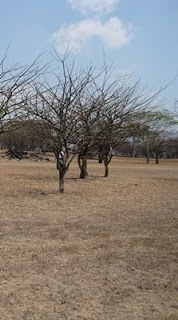Look, Listen and Learn: All in a Day's Work
 |
| Exterior of the Unidad de Salud |
 |
| In the morning, these chairs are filled with waiting patients |
The conversation with the director was incredibly helpful. We explained that one day of the mission in the coming year is designated for the communities around Guazapa. The local pastors coordinate transportation for families to travel to the Mission of Healing site - a large open-air property which belongs to the church near Nejapa. Right out of the box the director was eager to have staff members from the Guazapa Unidad accompany the people. They could work alongside the US team and other Salvadoran volunteers. They could see patients identified with chronic diseases and make the plans for follow-up care. He offered a dentist, someone to do pap smears - it was incredible!
We talked a lot about medications. We are strongly committed to purchasing as many medications as possible in El Salvador. We certainly have had challenges bringing medications into the country (despite following all of the customs rules), and if we can support local production of quality medications, we want to do that. With the implementation of healthcare reforms, medication prices have come down and availability has greatly increased.
At this point, one of the pastors in our meeting said, "But the medications from the US are so much better quality than those in El Salvador." We hear this all the time - people do not trust the quality of their locally produced medications. The director jumped right onto this point: "You are a man of faith, right? You know that people need to believe in their medications. Faith plus medicine. There is competition now, the medications are of a good quality and people need to believe that. As leaders, we need to model that belief for the people."
We have struggled with finding the best way in which to provide care for chronically ill patients. Initially we did not treat them (heart-breaking for patients with blood sugar and blood pressure levels off the charts). Then, we tried leaving a year's worth of medication with the Lutheran Clinic, but follow-up and transportation were big issues. We told the director that by developing stronger ties with the local Unidades, our hope is to incorporate local doctors into the Mission of Healing so that right on the spot they can make the follow-up plans. Throughout the year, local pastors can provide encouragement and support to their people who need to follow a regimen of care.
We learned about dengue and chikungunya, and the protocols for treating these diseases for children, adults, pregnant women and the elderly. The director provided us with a wealth of useful information. In the midst of my notes about malnutrition and the Barcelona Study, I found this memorable quote from the director: "People need to eat foods that are REAL." We were feeling good synergy with the director. With it's fifteen year history, the Mission of Healing provides a place of education and encouragement, a place where medicine and faith work together, a place where patients feel loved and listened to and cared for by their church and by doctors. We hope to be moving forward in a good way that incorporates more local healers and encourages continued care and education throughout the year.
After the meeting, Deb and I were invited to observe one of the physicians. The doctor introduced us to each patient, asking if it was OK for us to observe. He was very attentive, from listening to the stories of an older woman with pain everywhere to carefully reassuring a new mom with her 5-day-old baby. During his free moments between patients, he showed us all of the different paperwork he has and gave us bits of information about his practice:
- He sees 6 patients per hour - that is what is allowed by the government
- He has 20 active cases of tuberculosis - and his patients come 3 times a week for treatment
- Upper respiratory illnesses and dermatitis are the most common diagnoses
- Malnutrition is terrible and anemia is high
- The number of patients with high cholesterol is increasing
- The number of cases of renal insufficiency is increasing rapidly - especially in males age 22 to 25. It is most frequent among men over age 50 who worked in the cane fields.
- Diarrhea from roto-virus is common due to flies and lack of hand-washing
- Violence is a big problem with the people because "they are violent inside"
 |
| Emergency Room |
 |
| One ambulance - 3 patients |
We concluded our observation time, ate lunch in little place down the street, and returned to take a tour of the pharmacy and the lab. The pharmacy was small, but air-conditioned, which we discovered is the norm for the Unidades de Salud in the north. This is really important for preserving the shelf life of medications in the heat and humidity. Because the Guazapa Unidad does not have any specialty doctors, they cannot stock specialty medications (for example, their only gynecological medication was over-the-counter cream). Still, we were pleased to see many common medications in stock, and we took note of things that are needed. After we visited a variety of pharmacies, we were better able to evaluate the availability of medications at each location. The lab deserves it's own special story...stay tuned for that one!
We looked. We listened. In just one day, we learned so much! The eagerness and willingness of the staff to share their routines, their knowledge, their frustrations, their hopes and their enthusiasm for new connections was amazing.


Comments
Post a Comment